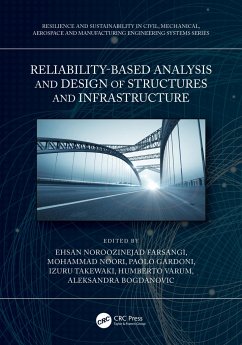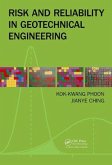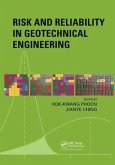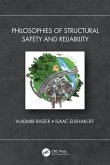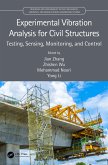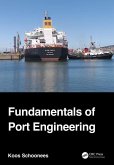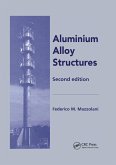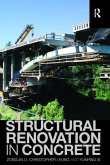Reliability-Based Analysis and Design of Structures and Infrastructure
Herausgeber: Noroozinejad Farsangi, Ehsan; Gardoni, Paolo; Noori, Mohammad
Reliability-Based Analysis and Design of Structures and Infrastructure
Herausgeber: Noroozinejad Farsangi, Ehsan; Gardoni, Paolo; Noori, Mohammad
- Gebundenes Buch
- Merkliste
- Auf die Merkliste
- Bewerten Bewerten
- Teilen
- Produkt teilen
- Produkterinnerung
- Produkterinnerung
This book presents an overview of the methods of classical reliability analysis and design most associated with structural reliability. It also introduces more modern methods and advancements, and emphasizes the most useful methods and techniques used in reliability and risk studies.
Andere Kunden interessierten sich auch für
![Risk and Reliability in Geotechnical Engineering Risk and Reliability in Geotechnical Engineering]() Risk and Reliability in Geotechnical Engineering275,99 €
Risk and Reliability in Geotechnical Engineering275,99 €![Risk and Reliability in Geotechnical Engineering Risk and Reliability in Geotechnical Engineering]() Risk and Reliability in Geotechnical Engineering97,99 €
Risk and Reliability in Geotechnical Engineering97,99 €![Philosophies of Structural Safety and Reliability Philosophies of Structural Safety and Reliability]() Vladimir RaizerPhilosophies of Structural Safety and Reliability148,99 €
Vladimir RaizerPhilosophies of Structural Safety and Reliability148,99 €![Experimental Vibration Analysis for Civil Structures Experimental Vibration Analysis for Civil Structures]() Experimental Vibration Analysis for Civil Structures161,99 €
Experimental Vibration Analysis for Civil Structures161,99 €![Fundamentals of Port Engineering Fundamentals of Port Engineering]() Koos Schoonees (South Africa Stellenbosch University)Fundamentals of Port Engineering178,99 €
Koos Schoonees (South Africa Stellenbosch University)Fundamentals of Port Engineering178,99 €![Aluminium Alloy Structures Aluminium Alloy Structures]() Federico MazzolaniAluminium Alloy Structures85,99 €
Federico MazzolaniAluminium Alloy Structures85,99 €![Structural Renovation in Concrete Structural Renovation in Concrete]() Zongjin Li (Hong Kong University of Science and Technology)Structural Renovation in Concrete111,99 €
Zongjin Li (Hong Kong University of Science and Technology)Structural Renovation in Concrete111,99 €-
-
-
This book presents an overview of the methods of classical reliability analysis and design most associated with structural reliability. It also introduces more modern methods and advancements, and emphasizes the most useful methods and techniques used in reliability and risk studies.
Hinweis: Dieser Artikel kann nur an eine deutsche Lieferadresse ausgeliefert werden.
Hinweis: Dieser Artikel kann nur an eine deutsche Lieferadresse ausgeliefert werden.
Produktdetails
- Produktdetails
- Resilience and Sustainability in Civil, Mechanical, Aerospace and Manufacturing Engineering Systems
- Verlag: Taylor & Francis Ltd
- Seitenzahl: 505
- Erscheinungstermin: 28. September 2021
- Englisch
- Abmessung: 254mm x 178mm x 29mm
- Gewicht: 1148g
- ISBN-13: 9780367758080
- ISBN-10: 0367758083
- Artikelnr.: 62229044
- Herstellerkennzeichnung
- Libri GmbH
- Europaallee 1
- 36244 Bad Hersfeld
- gpsr@libri.de
- Resilience and Sustainability in Civil, Mechanical, Aerospace and Manufacturing Engineering Systems
- Verlag: Taylor & Francis Ltd
- Seitenzahl: 505
- Erscheinungstermin: 28. September 2021
- Englisch
- Abmessung: 254mm x 178mm x 29mm
- Gewicht: 1148g
- ISBN-13: 9780367758080
- ISBN-10: 0367758083
- Artikelnr.: 62229044
- Herstellerkennzeichnung
- Libri GmbH
- Europaallee 1
- 36244 Bad Hersfeld
- gpsr@libri.de
Dr. Ehsan Noroozinejad Farsangi is currently serving as an A/Professor in the Department of Earthquake and Geotechnical Engineering at the Graduate University of Advanced Technology, Iran. Dr. Noroozinejad is the Founder and Chief Editor of the International Journal of Earthquake and Impact Engineering, the Associate Editor of the ASCE Practice Periodical on Structural Design and Construction, the Associate Editor of the IET Journal of Engineering, the Associate Editor of Frontiers in Built Environment: Earthquake Engineering Section, the Associate Editor of the Open Civil Engineering Journal, the Associate Editor of the Journal of Applied Science and Engineering, the Editor of the Journal of Reliability Engineering and Resilience, and the Trial Engineering Editor of ASCE Natural Hazards Review. He is also the Core member of the FIB Commission on Resilient RC Structures, the ASCE Objective Resilience Committee, the ASCE Risk and Resilience Measurements Committee, the ASCE Civil Infrastructure and Lifeline Systems Committee, the ASCE Structural Health Monitoring & Control Committee, and also the IEEE P693 Committee on Seismic Design for Substations. He has more than 50 journal papers in indexed journals and has published 4 books with reputed publishers in his field of expertise. His main research interests include; structural and geotechnical earthquake engineering, structural dynamics, computational dynamics, smart structures, solid and fracture mechanics, resilience-based design, reliability analysis, artificial intelligence, SSI, and vibration control in structures and infrastructure under extreme loading. Dr. Mohammad Noori is a professor of Mechanical Engineering at Cal Poly, San Luis Obispo, a Fellow of the American Society of Mechanical Engineering and a recipient of the Japan Society for Promotion of Science Fellowship. Noori's work in nonlinear random vibrations, seismic isolation and application of artificial intelligence methods for structural health monitoring is widely cited. He has authored over 250 refereed papers, including over 100 journal articles, 6 scientific books, and has edited 25 technical, and special journals, volumes. Noori has supervised over 90 graduate students and post-doc scholars, and has presented over 100 keynotes, plenary, and invited talks. He is the founding executive editor of an international journal and has served on the editorial boards of over 10 other journals and as a member of numerous scientific and advisory boards. He has been a Distinguished Visiting Professor at several highly ranked global universities, and directed the Sensors Program at the National Science Foundation in 2014. He has been a founding director or co-founder of three industry-university research centers and held Chair professorships at two major universities. He served as the dean of engineering at Cal Poly for five years, has also served as the Chair of the national committee of mechanical engineering department heads, and was one of 7 co-founders of the National Institute of Aerospace, in partnership with NASA Langley Research Center. Noori also serves as the Chief Technical Advisor for several scientific organizations and industries. Dr. Paolo Gardoni is a Professor and Excellence Faculty Scholar in the Department of Civil and Environmental Engineering at the University of Illinois at Urbana-Champaign. He is the Director of the MAE Center that focuses on creating a Multi-hazard Approach to Engineering, and the Associate Director of the NIST-funded Center of Excellence for Risk-based Community Resilience Planning. Dr. Gardoni is the founder and Editor-in-Chief of the international journal Sustainable and Resilient Infrastructure published by Taylor and Francis Group. He is a member of the Board of Directors of the International Civil Engineering Risk and Reliability Association (CERRA), of the Advisory Council of the International Forum on Engineering Decision Making (IFED), and of a number of national and international committees and associations that focus on risk and reliability analysis. Dr. Gardoni's research interests include sustainable and resilient infrastructure; reliability, risk and life cycle analysis; decision making under uncertainty; performance assessment of deteriorating systems; ethical, social, and legal dimensions of risk; and policies for natural hazard mitigation and disaster recovery. He is the author of over 150 refereed journal papers, 27 book chapters, and 7 edited volumes. He has received over $50 million in research funding from multiple national and international agencies including the National Science Foundation (NSF), the Qatar National Research Funds (QNRF), the National Institute of Standards and Technology (NIST), the Nuclear Regulatory Commission (NRC) and the United States Army Corps of Engineers. Dr. Gardoni has given over 40 invited and keynote lectures around the world. Dr. Izuru Takewaki is a Professor at Kyoto University, Kyoto, Japan. He also graduated in Architectural Engineering from Kyoto University. After Ph.D. in 1991 on structural optimization and inverse vibration problems at Kyoto University, he focused on critical excitation method and earthquake resilience at Kyoto University, where he is currently a professor. He is the 56th President of Architectural Institute of Japan (AIJ) since 2019. He is the Field Chief Editor of Frontiers in Built Environment (Switzerland) and also the Specialty Chief Editor of Section 'Earthquake Engineering' in the same journal. He is serving as an editorial board member in several world-leading international journals including Soil Dynamics and Earthquake Engineering (Elsevier). He published over 200 International Journal Papers and his h-index is 32. His research interests include resilience-based design of structures, seismic-resistant design of building structures, structural control, base isolation, inverse problem in vibration, structural optimization, soil-structure interaction, random vibration theory, critical excitation method, structural health monitoring, system identification. He was awarded numerous prizes, e.g. the Research Prize of AIJ in 2004, the 2008 Paper of the Year in J. of The Structural Design of Tall and Special Buildings (Wiley), the Prize of AIJ for Book in 2014. Dr. Humberto Varum is a Professor and Director of the Ph.D. Program in Civil Engineering at the Faculty of Engineering of the University of Porto (FEUP), Portugal. Since October 2010, he is an Honorary Lecturer at the Department of Civil, Environmental and Geomatic Engineering, University College of London (UCL), United Kingdom. Since July 2016, he is Visiting Professor at the College of Civil Engineering, Fuzhou University, Fujian, China. He has been Seconded National Expert to the ELSA laboratory, Joint Research Centre, European Commission, Italy, in the period July 2009 to August 2010. He is an Integrated Member and Vice-Coordinator of CONSTRUCT research unit: Institute of R&D in Structures and Construction (FEUP). Since May 2015, he his Member of the Directorate Body of the Construction Institute of the University of Porto, and President since May 2019. He is a Member of the National Committee of the International Council on Monuments and Sites (ICOMOS), since 2009, and Expert Member of the ICOMOS's International Scientific Committee of Earthen Architectural Heritage (ISCEAH). He is a Member of the Project Team 2 for the development of the second generation of EN Eurocodes. He is a Member of the Mexican Academy of Engineering, since 2018. Since June 2019, he is External Researcher of Grupo de Gestión de Riesgos de Desastres en Infraestructura Social y Vivienda de Bajo Costo (GERDIS), Pontificia Universidad Católica del Perú (PUCP), Peru. He is a Member of the International Scientific Board (ISB) of AdMaS (Advanced Materials, Structures and Technologies) centre, Faculty of Civil Engineering, Brno University of Technology, Czech Republic, since 2013. He has participated to post-earthquake field reconnaissance missions, in particular to L'Aquila (Italy, 2009), Lorca (Spain, 2011), Emilia-Romagna (Italy, 2012), Gorkha (Nepal, 2015) and Puebla (Mexico, 2017). His main research interests include: assessment, strengthening and repair of structures, earthquake engineering, historic constructions conservation and strengthening. Dr. Aleksandra Bogdanovic is an Associate Professor in the subject Design and Analysis of structures with seismic isolation and passive system for energy dissipation, at the international master and doctoral studies at Institute of Earthquake Engineering and Engineering Seismology IZIIS, University "Ss. Cyril and Methodius". Her main professional activities are related to research and education in civil engineering, earthquake engineering, structural control and health monitoring, experimental testing and analysis of the structures. Her doctoral studies were performed within the framework of international SEEFORM/DAAD Program under which she realized several months of study stay in RWTH Aachen in 2009. She has been a participant form IZIIS in FP7 SERIES project (2009-2013, Grant No 227887.), FP7 UREDITEME Project (2009-2012, Grant No 230099), as well as, deputy assistant in WP 14 in H2020 SERA Project (2017-2020, Grant No 730900). She has published more than 40 scientific papers in national and international conferences, more than 60 professional reports and more than 20 publications in journals. She has received an award for the notable achievement in the civil engineering practice granted by the Macedonian Association of Structural Engineers in 2015. She is a member of the Macedonian Association of Earthquake Engineering MAEE and European Association of Earthquake Engineering EAEE.
Chapter 1. Reliability-Based Design Optimization.
Chapter 2. Reliability-based Structural Vibration Control.
Chapter 3. Seismic Reliability-Based Design of elastic and inelastic
structural systems equipped with seismic devices.
Chapter 4. Why Resilience-Based Design?.
Chapter 5. Resilience Engineering: Principles, Methods and Applications to
Critical Infrastructure Systems.
Chapter 6. Resilience Based Design of Buildings.
Chapter 7. Positioning Resilience in Design and Analysis of Structures and
Infrastructure.
Chapter 8. Stochastic finite element method.
Chapter 9. Structural Health Monitoring-integrated Reliability Assessment
of Engineering Structures.
Chapter 10. Time-dependent reliability of aging structures exposed to
imprecise deterioration information.
Chapter 11. Non-linear numerical analyses of reinforced concrete
structures: safety formats, aleatory and epistemic uncertainties.
Chapter 12. Risk-based Seismic Assessment of Curved Damper Truss Moment
Frame .
Chapter 13. Risk-Target Based Design of base-isolated buildings.
Chapter 14. Structural performance evaluation system for improved building
resilience and reliability.
Chapter 15. Line sampling simulation: recent advancements and applications.
Chapter 16. Probabilistic performance analysis of modern RC frame
structures subjected to earthquake loading.
Chapter 17. Research on safety assessment and maintenance decision for the
metal structure of the casting crane.
Chapter 18. Seismic Risk Based Design for Bridge.
Chapter 19. Maximum entropy method for probabilistic quantification of soil
properties: a case study of Nipigon River landslide in Ontario, Canada.
Chapter 20. Advances in Online Decentralized Structural Identification.
Chapter 21. Stochastic optimization methods in machine learning.
Chapter 22. Period-height relationships for the design, assessment and
reliability analysis of code-compliant reinforced concrete frames .
Chapter 23. Reliability of the Rehabilitation of the Monumental Buildings
in Seismic Regions.
Chapter 24. Reliability Based Analyses and Design of Pipelines Under Ground
Movements During Earthquakes.
Chapter 25. Optimal design of hysteretic damper with stopper mechanism for
tall buildings under earthquake ground motions of extremely large
amplitude.
Chapter 26. Reliability analysis and resilience assessment of substation
systems using the state tree method: a framework and application.
Chapter 27. Reliability-Based Methods for Inspection Planning and
Predictive Maintenance in Fixed Offshore Structures.
Chapter 28. Load and Resistance Factor Design Involving Random Variables
with Unknown Probability Distributions.
Chapter 29. Methods of Moment for System Reliability.
Chapter 30. Reliability-based design optimization using transfer learning.
Chapter 2. Reliability-based Structural Vibration Control.
Chapter 3. Seismic Reliability-Based Design of elastic and inelastic
structural systems equipped with seismic devices.
Chapter 4. Why Resilience-Based Design?.
Chapter 5. Resilience Engineering: Principles, Methods and Applications to
Critical Infrastructure Systems.
Chapter 6. Resilience Based Design of Buildings.
Chapter 7. Positioning Resilience in Design and Analysis of Structures and
Infrastructure.
Chapter 8. Stochastic finite element method.
Chapter 9. Structural Health Monitoring-integrated Reliability Assessment
of Engineering Structures.
Chapter 10. Time-dependent reliability of aging structures exposed to
imprecise deterioration information.
Chapter 11. Non-linear numerical analyses of reinforced concrete
structures: safety formats, aleatory and epistemic uncertainties.
Chapter 12. Risk-based Seismic Assessment of Curved Damper Truss Moment
Frame .
Chapter 13. Risk-Target Based Design of base-isolated buildings.
Chapter 14. Structural performance evaluation system for improved building
resilience and reliability.
Chapter 15. Line sampling simulation: recent advancements and applications.
Chapter 16. Probabilistic performance analysis of modern RC frame
structures subjected to earthquake loading.
Chapter 17. Research on safety assessment and maintenance decision for the
metal structure of the casting crane.
Chapter 18. Seismic Risk Based Design for Bridge.
Chapter 19. Maximum entropy method for probabilistic quantification of soil
properties: a case study of Nipigon River landslide in Ontario, Canada.
Chapter 20. Advances in Online Decentralized Structural Identification.
Chapter 21. Stochastic optimization methods in machine learning.
Chapter 22. Period-height relationships for the design, assessment and
reliability analysis of code-compliant reinforced concrete frames .
Chapter 23. Reliability of the Rehabilitation of the Monumental Buildings
in Seismic Regions.
Chapter 24. Reliability Based Analyses and Design of Pipelines Under Ground
Movements During Earthquakes.
Chapter 25. Optimal design of hysteretic damper with stopper mechanism for
tall buildings under earthquake ground motions of extremely large
amplitude.
Chapter 26. Reliability analysis and resilience assessment of substation
systems using the state tree method: a framework and application.
Chapter 27. Reliability-Based Methods for Inspection Planning and
Predictive Maintenance in Fixed Offshore Structures.
Chapter 28. Load and Resistance Factor Design Involving Random Variables
with Unknown Probability Distributions.
Chapter 29. Methods of Moment for System Reliability.
Chapter 30. Reliability-based design optimization using transfer learning.
Chapter 1. Reliability-Based Design Optimization.
Chapter 2. Reliability-based Structural Vibration Control.
Chapter 3. Seismic Reliability-Based Design of elastic and inelastic
structural systems equipped with seismic devices.
Chapter 4. Why Resilience-Based Design?.
Chapter 5. Resilience Engineering: Principles, Methods and Applications to
Critical Infrastructure Systems.
Chapter 6. Resilience Based Design of Buildings.
Chapter 7. Positioning Resilience in Design and Analysis of Structures and
Infrastructure.
Chapter 8. Stochastic finite element method.
Chapter 9. Structural Health Monitoring-integrated Reliability Assessment
of Engineering Structures.
Chapter 10. Time-dependent reliability of aging structures exposed to
imprecise deterioration information.
Chapter 11. Non-linear numerical analyses of reinforced concrete
structures: safety formats, aleatory and epistemic uncertainties.
Chapter 12. Risk-based Seismic Assessment of Curved Damper Truss Moment
Frame .
Chapter 13. Risk-Target Based Design of base-isolated buildings.
Chapter 14. Structural performance evaluation system for improved building
resilience and reliability.
Chapter 15. Line sampling simulation: recent advancements and applications.
Chapter 16. Probabilistic performance analysis of modern RC frame
structures subjected to earthquake loading.
Chapter 17. Research on safety assessment and maintenance decision for the
metal structure of the casting crane.
Chapter 18. Seismic Risk Based Design for Bridge.
Chapter 19. Maximum entropy method for probabilistic quantification of soil
properties: a case study of Nipigon River landslide in Ontario, Canada.
Chapter 20. Advances in Online Decentralized Structural Identification.
Chapter 21. Stochastic optimization methods in machine learning.
Chapter 22. Period-height relationships for the design, assessment and
reliability analysis of code-compliant reinforced concrete frames .
Chapter 23. Reliability of the Rehabilitation of the Monumental Buildings
in Seismic Regions.
Chapter 24. Reliability Based Analyses and Design of Pipelines Under Ground
Movements During Earthquakes.
Chapter 25. Optimal design of hysteretic damper with stopper mechanism for
tall buildings under earthquake ground motions of extremely large
amplitude.
Chapter 26. Reliability analysis and resilience assessment of substation
systems using the state tree method: a framework and application.
Chapter 27. Reliability-Based Methods for Inspection Planning and
Predictive Maintenance in Fixed Offshore Structures.
Chapter 28. Load and Resistance Factor Design Involving Random Variables
with Unknown Probability Distributions.
Chapter 29. Methods of Moment for System Reliability.
Chapter 30. Reliability-based design optimization using transfer learning.
Chapter 2. Reliability-based Structural Vibration Control.
Chapter 3. Seismic Reliability-Based Design of elastic and inelastic
structural systems equipped with seismic devices.
Chapter 4. Why Resilience-Based Design?.
Chapter 5. Resilience Engineering: Principles, Methods and Applications to
Critical Infrastructure Systems.
Chapter 6. Resilience Based Design of Buildings.
Chapter 7. Positioning Resilience in Design and Analysis of Structures and
Infrastructure.
Chapter 8. Stochastic finite element method.
Chapter 9. Structural Health Monitoring-integrated Reliability Assessment
of Engineering Structures.
Chapter 10. Time-dependent reliability of aging structures exposed to
imprecise deterioration information.
Chapter 11. Non-linear numerical analyses of reinforced concrete
structures: safety formats, aleatory and epistemic uncertainties.
Chapter 12. Risk-based Seismic Assessment of Curved Damper Truss Moment
Frame .
Chapter 13. Risk-Target Based Design of base-isolated buildings.
Chapter 14. Structural performance evaluation system for improved building
resilience and reliability.
Chapter 15. Line sampling simulation: recent advancements and applications.
Chapter 16. Probabilistic performance analysis of modern RC frame
structures subjected to earthquake loading.
Chapter 17. Research on safety assessment and maintenance decision for the
metal structure of the casting crane.
Chapter 18. Seismic Risk Based Design for Bridge.
Chapter 19. Maximum entropy method for probabilistic quantification of soil
properties: a case study of Nipigon River landslide in Ontario, Canada.
Chapter 20. Advances in Online Decentralized Structural Identification.
Chapter 21. Stochastic optimization methods in machine learning.
Chapter 22. Period-height relationships for the design, assessment and
reliability analysis of code-compliant reinforced concrete frames .
Chapter 23. Reliability of the Rehabilitation of the Monumental Buildings
in Seismic Regions.
Chapter 24. Reliability Based Analyses and Design of Pipelines Under Ground
Movements During Earthquakes.
Chapter 25. Optimal design of hysteretic damper with stopper mechanism for
tall buildings under earthquake ground motions of extremely large
amplitude.
Chapter 26. Reliability analysis and resilience assessment of substation
systems using the state tree method: a framework and application.
Chapter 27. Reliability-Based Methods for Inspection Planning and
Predictive Maintenance in Fixed Offshore Structures.
Chapter 28. Load and Resistance Factor Design Involving Random Variables
with Unknown Probability Distributions.
Chapter 29. Methods of Moment for System Reliability.
Chapter 30. Reliability-based design optimization using transfer learning.

